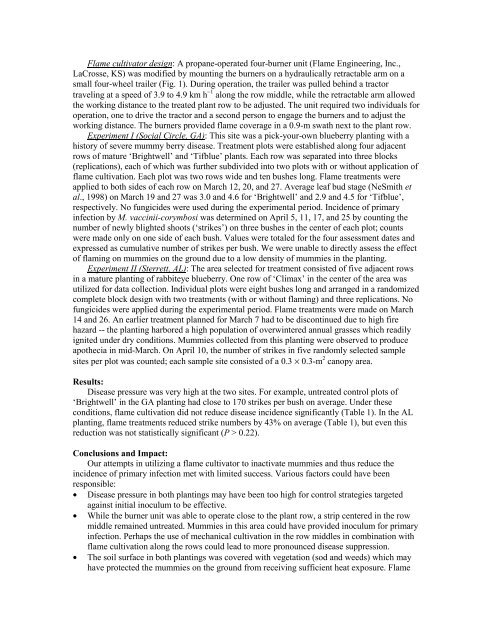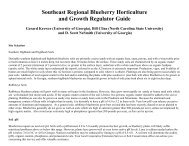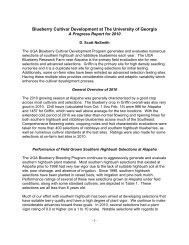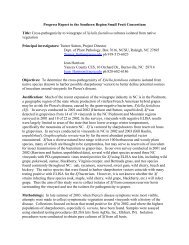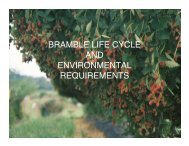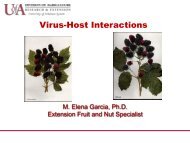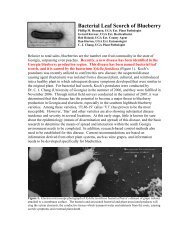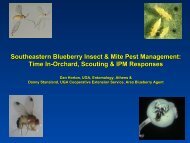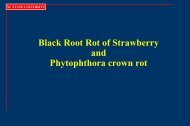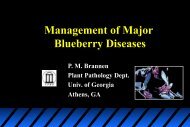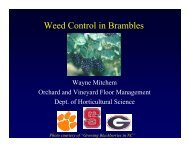Progress Report for Research Funding
Progress Report for Research Funding
Progress Report for Research Funding
- No tags were found...
You also want an ePaper? Increase the reach of your titles
YUMPU automatically turns print PDFs into web optimized ePapers that Google loves.
Flame cultivator design: A propane-operated four-burner unit (Flame Engineering, Inc.,LaCrosse, KS) was modified by mounting the burners on a hydraulically retractable arm on asmall four-wheel trailer (Fig. 1). During operation, the trailer was pulled behind a tractortraveling at a speed of 3.9 to 4.9 km h −1 along the row middle, while the retractable arm allowedthe working distance to the treated plant row to be adjusted. The unit required two individuals <strong>for</strong>operation, one to drive the tractor and a second person to engage the burners and to adjust theworking distance. The burners provided flame coverage in a 0.9-m swath next to the plant row.Experiment I (Social Circle, GA): This site was a pick-your-own blueberry planting with ahistory of severe mummy berry disease. Treatment plots were established along four adjacentrows of mature ‘Brightwell’ and ‘Tifblue’ plants. Each row was separated into three blocks(replications), each of which was further subdivided into two plots with or without application offlame cultivation. Each plot was two rows wide and ten bushes long. Flame treatments wereapplied to both sides of each row on March 12, 20, and 27. Average leaf bud stage (NeSmith etal., 1998) on March 19 and 27 was 3.0 and 4.6 <strong>for</strong> ‘Brightwell’ and 2.9 and 4.5 <strong>for</strong> ‘Tifblue’,respectively. No fungicides were used during the experimental period. Incidence of primaryinfection by M. vaccinii-corymbosi was determined on April 5, 11, 17, and 25 by counting thenumber of newly blighted shoots (‘strikes’) on three bushes in the center of each plot; countswere made only on one side of each bush. Values were totaled <strong>for</strong> the four assessment dates andexpressed as cumulative number of strikes per bush. We were unable to directly assess the effectof flaming on mummies on the ground due to a low density of mummies in the planting.Experiment II (Sterrett, AL): The area selected <strong>for</strong> treatment consisted of five adjacent rowsin a mature planting of rabbiteye blueberry. One row of ‘Climax’ in the center of the area wasutilized <strong>for</strong> data collection. Individual plots were eight bushes long and arranged in a randomizedcomplete block design with two treatments (with or without flaming) and three replications. Nofungicides were applied during the experimental period. Flame treatments were made on March14 and 26. An earlier treatment planned <strong>for</strong> March 7 had to be discontinued due to high firehazard -- the planting harbored a high population of overwintered annual grasses which readilyignited under dry conditions. Mummies collected from this planting were observed to produceapothecia in mid-March. On April 10, the number of strikes in five randomly selected samplesites per plot was counted; each sample site consisted of a 0.3 × 0.3-m 2 canopy area.Results:Disease pressure was very high at the two sites. For example, untreated control plots of‘Brightwell’ in the GA planting had close to 170 strikes per bush on average. Under theseconditions, flame cultivation did not reduce disease incidence significantly (Table 1). In the ALplanting, flame treatments reduced strike numbers by 43% on average (Table 1), but even thisreduction was not statistically significant (P > 0.22).Conclusions and Impact:Our attempts in utilizing a flame cultivator to inactivate mummies and thus reduce theincidence of primary infection met with limited success. Various factors could have beenresponsible:• Disease pressure in both plantings may have been too high <strong>for</strong> control strategies targetedagainst initial inoculum to be effective.• While the burner unit was able to operate close to the plant row, a strip centered in the rowmiddle remained untreated. Mummies in this area could have provided inoculum <strong>for</strong> primaryinfection. Perhaps the use of mechanical cultivation in the row middles in combination withflame cultivation along the rows could lead to more pronounced disease suppression.• The soil surface in both plantings was covered with vegetation (sod and weeds) which mayhave protected the mummies on the ground from receiving sufficient heat exposure. Flame


